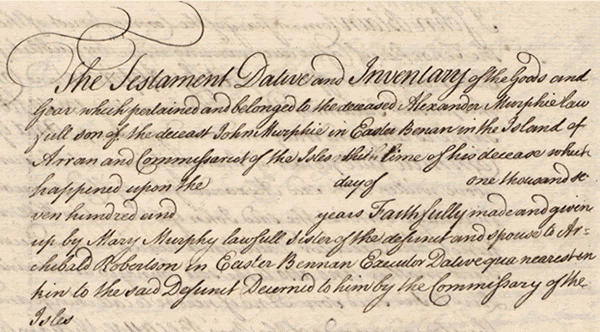6. The Introductory Clause
The first clause of a testament is the introductory clause in which the executor declares the identity and date of death of the deceased and the relationship between the executor and the deceased. In this case, Mary Murphy was unable to give a precise date of death, so the clerk left blanks for the day, month and year (such blanks are quite common in testaments dative). Her relationship to the deceased and her right to movables were confirmed by the court.
In the image below note some of the words and phrases, which occur commonly in testaments:
| Term | Definition |
|---|---|
| Goods and gear | movable property |
| Pertained | belonged to or legally connected to a person |
| Time of his/her decease | time of his/her death |
| Faithfully made and given up | accurately made and presented in court |
| Defunct | the deceased |
| Executor dative qua nearest in kin | family member appointed executor by the court |
| Decerned | decreed by a court |

Crown copyright, National Records of Scotland, CC12/3/6, p16
Exercise 1
In the transcription below fill in the missing common phrases by typing in the appropriate blank spaces. The text will be red as you type and will turn black when you have transcribed the word correctly. The answers are case- sensitive, so make sure you have used capital letters where appropriate.
The Testament Dative and Inventary of the
which and belonged to the deceased Alexander Murphie law-
full son of the deceast John Murphie in Easter Bennan in the Island of
Arran and Commissariot of the Isles the which
happened upon the [blank] day of [blank] one thousand se-
ven hundred and [blank] years and
by Mary Murphy lawfull sister of the and spouse to Ar-
chibald Robertson in Easter Bennan
to the said Defunct to him by the Commissary of the
Isles